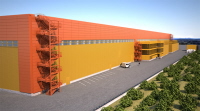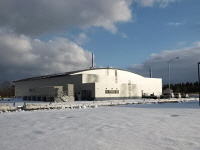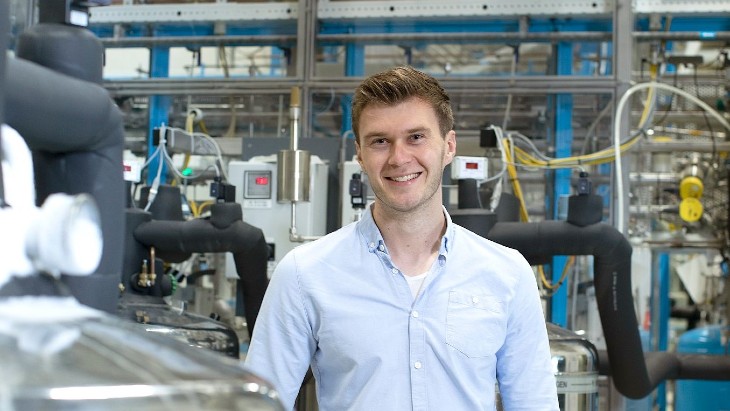Fusion projects building for the future
Tuesday, 19 January 2010
The contract for the Coil Winding Facility heralds the beginning of Iter construction at the Cadarache site. It will house the workshop where some of the international fusion project's largest components - the coils for the Poloid Field (PF) magnets - will be wound. Most of the components for Iter are being built at existing industrial installations in Iter's member countries, but five of the six PF coils - which range in diameter from 8 to 24 metres - are simply too big to be transported and therefore must be wound on site.
At 253 metres long, 46 metres wide and 19 metres high, the Coil Winding Facility will be one of the largest of the 39 buildings that will be erected on the Iter platform over the coming years. The construction contract was signed on 13 January by Didier Gambier of the European Domestic Agency and Francois-Xavier Clédat, president of the French consortium that will be building the massive structure. Work is expected to start in the middle of this year.
Iter is an international project aiming to demonstrate the use of nuclear fusion to produce useful energy, but will not actually generate electricity. Although Iter is not expected to achieve deuterium-tritium fusion until 2026, plans are already in place for the demonstration and prototype plants (known as Demo and Proto) that will come after it, ultimately leading to commercial fusion power plants.
Building for the future
One of the many considerations in such future power plants will be the development and characterization of materials that can withstand the intense flux of highly energetic neutrons in the deuterium-tritium plasma where fusion takes place. This is not a particular problem for Iter, but will be crucial in the later reactors. The International Fusion Materials Irradiation Facility (IFMIF), a project to develop and investigate the special materials that will be needed in the successors to Iter, is also progressing towards the establishment of its own dedicated prototype facilities.
IFMIF, launched in 2007, is currently in the engineering validation and engineering design activities (EVEDA) phase, and is developing prototypes to validate technologies for an accelerator and also a lithium test loop. Design activities for the IFMIF are taking place at various European and Japanese institutes, coordinated from Rokkasho in Japan.
The IFMIF accelerator will reproduce the conditions in an operating fusion reactor using accelerated deuterium interacting with a fast-flowing film of liquid lithium to generate neutrons of the required energy. According to IFMIF project leader Pascal Garin, the flux rate achieved in the accelerator will be slightly above that of a reactor, meaning that six years of irradiation would replicate the degradation equivalent to that seen in ten years of continuous operation of a fusion reactor.
The prototype for the accelerator is already being manufactured in various locations in Europe, and the Japanese Atomic Energy Agency (JAEA) has already prepared a building at Rokkasho to host the facility, where components are expected to start arriving in 2011.
The lithium loop will also be located in Japan at a dedicated facility at Oarai.
"Four or five years from now, the IFMIF Engineering Design Report, the equivalent of the 2001 Iter Final Design Report, will be delivered," said Garin. "I hope that the process of deciding on a site for IFMIF will be launched before, in order to ensure some continuity between the current EVEDA phase and the construction phase."
Work is set to begin on the first building to be constructed at the Iter platform in France after a contract for the Coil Winding Facility was signed. Meanwhile, vital materials test facilities in Japan are progressing.
Work is set to begin on the first building to be constructed at the Iter platform in France after a contract for the Coil Winding Facility was signed. Meanwhile, test facilities to help prepare for the next stages in the international pursuit of nuclear fusion are progressing.
 |
| What the Coil Winding Facility will look like (Image: Iter) |
At 253 metres long, 46 metres wide and 19 metres high, the Coil Winding Facility will be one of the largest of the 39 buildings that will be erected on the Iter platform over the coming years. The construction contract was signed on 13 January by Didier Gambier of the European Domestic Agency and Francois-Xavier Clédat, president of the French consortium that will be building the massive structure. Work is expected to start in the middle of this year.
Iter is an international project aiming to demonstrate the use of nuclear fusion to produce useful energy, but will not actually generate electricity. Although Iter is not expected to achieve deuterium-tritium fusion until 2026, plans are already in place for the demonstration and prototype plants (known as Demo and Proto) that will come after it, ultimately leading to commercial fusion power plants.
Building for the future
One of the many considerations in such future power plants will be the development and characterization of materials that can withstand the intense flux of highly energetic neutrons in the deuterium-tritium plasma where fusion takes place. This is not a particular problem for Iter, but will be crucial in the later reactors. The International Fusion Materials Irradiation Facility (IFMIF), a project to develop and investigate the special materials that will be needed in the successors to Iter, is also progressing towards the establishment of its own dedicated prototype facilities.
 |
| The building that will house IFMIF's prototype accelerator at Rokkasho (Image: Iter) |
The IFMIF accelerator will reproduce the conditions in an operating fusion reactor using accelerated deuterium interacting with a fast-flowing film of liquid lithium to generate neutrons of the required energy. According to IFMIF project leader Pascal Garin, the flux rate achieved in the accelerator will be slightly above that of a reactor, meaning that six years of irradiation would replicate the degradation equivalent to that seen in ten years of continuous operation of a fusion reactor.
The prototype for the accelerator is already being manufactured in various locations in Europe, and the Japanese Atomic Energy Agency (JAEA) has already prepared a building at Rokkasho to host the facility, where components are expected to start arriving in 2011.
The lithium loop will also be located in Japan at a dedicated facility at Oarai.
"Four or five years from now, the IFMIF Engineering Design Report, the equivalent of the 2001 Iter Final Design Report, will be delivered," said Garin. "I hope that the process of deciding on a site for IFMIF will be launched before, in order to ensure some continuity between the current EVEDA phase and the construction phase."
Researched and written
by World Nuclear News
Most Read
_92619.jpg)
Deep Atomic launches SMR for data centres
Friday, 25 October 2024

Czech Republic selects Rolls-Royce SMR for small reactors project
Thursday, 19 September 2024

Iran outlines nuclear energy plans, including first concrete for Bushehr 3 this year
Friday, 27 September 2024
_84504.jpg)
Framatome to share fast reactor experience with Japan
Friday, 6 December 2024
Podcasts & Features
Viewpoint: The vital role of medical isotopes in theranostics
Podcasts & Features Tuesday, 22 July 2025
Viewpoint: Strategic coalitions in nuclear business
Podcasts & Features Tuesday, 8 July 2025

Related Links
Related Stories





..._58412.jpg)
